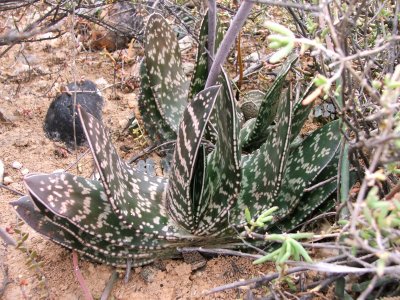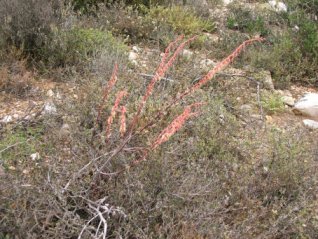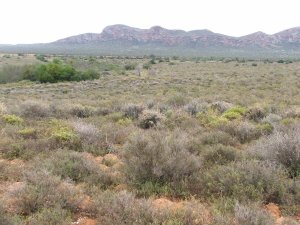Gasteria brachyphylla
Gasteria brachyphylla (Salm-Dyck) Van Jaarsv.
Family: Asphodelaceae
Common names: Klein Karoo ox-tongue (Eng.); Klein Karoo-beestong, boesmanrys (Afr.)
Introduction
Gasteria brachyphylla is a medium-sized aloe-like, succulent-leaved plant with smooth leaves in two opposite rows and an elongated raceme with pinkish flowers. It is widespread in the Klein Karoo (Western Cape Province). It thrives in cultivation.

Description
Description
Plants are 75-230 mm in diameter and have a short, decumbent to erect stem 25-230 mm high. They are prolific from the base, and form small clusters. The roots are succulent, up to 5 mm in diameter.
The leaves grow in two opposite rows and are 15-230 mm long 22-80 mm broad at the base and strap-shaped to rarely triangular-spear-shaped. The inner leaves are erect, becoming spreading. The upper surface is convex to flat and the lower surface is flat. The leaf epidermis (skin) is smooth and dark green; both surfaces have dense white spots arranged in obscure transverse bands; the margin is wavy, becoming continuous towards apex, leathery white and with small rounded teeth, the leaf ends are sharp to rounded, ending in a short sharp point. The juvenile leaves are strap-shapedand rough to the touch (asperulous), densely spotted and rounded at the end.

The inflorescence is a raceme, simple or with a pair of side branches, 200-900 (-1110) mm tall. The flower stalks (pedicels) are 5-7 mm long. The flowers (perianth) are 12-22 mm long, tubular, swollen at the base, thence constricted to a tube 3-4 mm in diameter; the swollen portion is pink, 5-7 mm in diameter; the flower tube is white with green striations. The stamens do not protrude. Flowering period: July-February, but mostly during September.
The fruiting capsule is oblong, 15-23 mm long, 7 mm broad and the flattish black seeds 3-4 mm long, 2-3 mm wide.
Gasteria brachyphylla is closely related to G. disticha which grows in the Robertson Karoo and has a rough leaf surface (almost like fine sandpaper, termed asperulous). Although both have leaves in two opposite rows, the former is immediately recognized by its smooth often shiny texture. Gasteria brachyphylla is an attractive medium-sized Gasteria species.
Two varieties of Gasteria brachyphylla are recognized (Van Jaarsveld 2007).
The typical variety (var. brachyphylla ) has leaves 9 0-230 x 30-80 mm with a pointed leaf tip. It grows mainly in the Klein Karoo in Succulent Karoo vegetation (Eastern Little Karoo of the Rainshadow Valley Karoo Bioregion) and in Gamka Thicket of the Albany Thicket Biome (Mucina & Rutherford 2006). Most of the images on this page are of this variety.
Gasteria brachyphylla var. bayeri is immediately distinguished from var. brachyphylla by its much smaller spreading leaves (leaves shorter than 50 mm) rounded at the point. This variety is only known from a few sites such as the hills surrounding Badspoort near Calitzdorp (Klein Karoo) and a site near Vanwyksdorp.
Conservation Status
Status
Gasteria brachyphylla is widespread and is not threatened in its habitat. It was therefore not necessary to include it in the Red Data Book (Raimondo et al. 2009).
Distribution and habitat
Distribution description
Gasteria brachyphylla is widely distributed in the Klein Karoo, the low lying arid region between the Swartberg and Langeberg mountain ranges. It occurs from Barrydale in the west, to near Uniondale in the east, and northwards to the Willowmore district between the Baviaanskloof and Swartberg mountain ranges. It is found at elevations of up to 1 000 m. It occurs in flat to mountainous terrain usually in shade of dwarf shrubs interspersed with taller shrubs. It grows mainly on shales and sandstones of the Bokkeveld Group (Cape Supergroup) as well as quartzitic sandstones and shales of the Table Mountain and Witteberg Group (Cape Supergroup). It has also been found to a lesser extent on Cenozoic alluvium, Mesozoic conglomerates of the Uitenhage group (Enon Formation) and Namibian limestones of the Kango Group. The soils are sandy and well drained and the pH varies between 4,7 (in sandstone) and 7,6 (in shale). The climate is hot and dry and when frost occurs it is mild. Rainfall, ranging between 200 and 300 mm per year, occurs in summer and winter but with a tendency to summer dryness.

Derivation of name and historical aspects
History
The specific Greek epithet 'brachyphylla ' means short-leaved ("brachy " = abbreviated or short and "phyllon ", leaf).
Gasteria brachyphylla was most probably first collected by Oldenland on the Schrijver expedition in 1689 in the Willowmore district and introduced to the 'Amsterdam Medicyn Hof' during the late seventeenth century. It was first cultivated in England by Mr Miller in 1731 (Aiton 1789). Prince Salm Dyck named named it Aloe brachyphylla in 1840, which was transferred to Gasteria in 1992 (Van Jaarsveld 1992).
This species has been featured on the front cover of Gasterias of South Africa (Van Jaarsveld 1994), as an illustration by the botanical artist, Elaphie Ward-Hilhorst.
The var. bayeri was first collected in March 1932 by H. H. Bolus. It was named for Mr Bruce Bayer, former curator of the Karoo National Botanical Garden (Van Jaarsveld 1992).
Ecology
Ecology
Gasteria brachyphylla often grows in shade of spiny karoo shrubs such as Carissa haematocarpa. The mottled greenish leaves are well camouflaged among the vegetation. The leaves become reddish brown tanned during drought and blend in with the natural surroundings. The flowers usually protrude above the shrubs where they are pollinated by sunbirds. Seeds ripen during summer. The capsules, when ripe, are held in an erect position and seeds are released by strong gusts of wind. The seeds are wind-dispersed. The succulent leaves and roots enable the plant to cope with the dry season and general dry conditions. Gasteria brachyphylla and most other Gasteria species have a vegetative propagation back-up: They are often eaten by animals. The leaves are brittle and, when leaf fragments drop to the ground after being eaten, they root and the portions sprout new offsets.
Uses
Use
Plants are occasionally cultivated on rockeries or in containers.
Growing Gasteria brachyphylla
Grow
Gasteria brachyphylla thrives in cultivation and does best as a pot plant or grown locally in rockeries in Succulent Karoo or Nama Karoo gardens. It is a slow grower. In other parts of the world it can also be grown out-of-doors, but is best cultivated in dry Mediterranean-type gardens where frost is not too severe (parts of California, USA, and the Mediterranean). Although it can be grown in full sun, plants prefer some slight shade, and in hot climates should therefore be protected from full sun. Plants should reach flowering size in about four years.
Propagation
Gasteria brachyphylla is easily propagated from seed, by division or from leaf cuttings. It is best to apply a fungicide when growing from seed. Sow seed during spring or summer in a warm, shady position in a sandy slightly acidic soil and keep moist. Cover with a thin layer of sand and keep moist. Germination is usually within three weeks. Seedlings grow slowly and are best planted out about a year after sowing. Propagation from leaf cuttings is best undertaken in spring. Allow the leaf cutting to form a heel by placing it on a dry windowsill for a week or three. Cuttings are best rooted in clean sand. Once rooted, plants can be planted into individual containers. Plants react well to organic feeding (compost or any other liquid fertilizer). Gasteria brachyphylla is best watered throughout the year.
References
- Aiton, W. 1789. Hortus Kewensis , edn 1. Nicol, London.
- Gunn, M. & Codd, L.E. Botanical exploration of southern Africa . Balkema, Cape Town.
- Raimondo, D., Von Staden, L., Foden, W.,Victor, J.E., Helme, N.A., Turner, R.C., Kamundi, D.A. & Manyama, P.A. (eds) 2009. Red List of South African plants 2009. Strelitzia 25. South African National Biodiversity Institute, Pretoria.
- Mucina, L. & Rutherford, M.C. (eds) 2006. The vegetation of South Africa, Lesotho and Swaziland. Strelitzia 19. South African National Biodiversity Institute, Pretoria.
- Van Jaarsveld, E.J. 1992. The genus Gasteria , a synoptic review. Aloe 29: 1-30.
- Van Jaarsveld, E.J. 1994. Gasterias of South Africa . Fernwood Press, Cape Town.
- Van Jaarsveld, E.J. 2007. The genus Gasteria, a synoptic review. Aloe 44: 4, 83-97.
- Van Jaarsveld, E.J. 2010. Waterwise gardening in South Africa and Namibia . Struik, Cape Town. [Author: not mentioned in text]
- Wijnands, O. 1983. The Botany of the Commelins . Balkema, Rotterdam.
Credits
Ernst van Jaarsveld
Kirstenbosch National Botanical Garden
August 2012
Plant Attributes:
Plant Type: Succulent
SA Distribution: Western Cape
Soil type: Sandy, Loam
Flowering season: Spring
PH: Acid, Neutral
Flower colour: Pink
Aspect: Full Sun, Shade, Morning Sun (Semi Shade)
Gardening skill: Average
Special Features:
Horticultural zones








Rate this article
Article well written and informative
Rate this plant
Is this an interesting plant?
Login to add your Comment
Back to topNot registered yet? Click here to register.